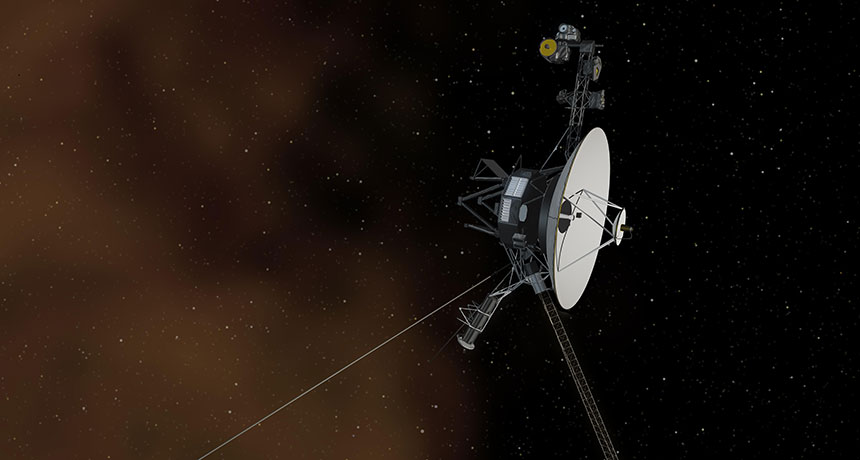Bon voyage, Voyager 1
A spacecraft launched more than three decades ago has entered the space between stars

This is the little spacecraft that could. Scientists report that on August 25, 2012, Voyager 1 entered the space between stars.
JPL-Caltech/NASA
NASA’s Voyager 1 has left our planetary neighborhood, and it’s not coming back. Scientists who work on the mission have reported that the spacecraft moved outside the sprawling bubble of electrically charged particles spewed by the sun. It marks the first time a human-built spacecraft has explored a mysterious region known as interstellar space.
“This is the beginning of a new era of exploration for us,” Edward Stone told Science News. Stone is a space scientist at the California Institute of Technology in Pasadena. He’s been in charge of the Voyager mission since 1972. “For the first time, we are exploring interstellar space.” Voyager 1 will continue to collect information from this unexplored region, which is packed with fast-moving particles from distant stars and supernovas.
The spacecraft, about the size of a small car, has been headed out since it launched in 1977. It was originally designed to visit the outer planets. Its tour included an approach to Jupiter in March 1979 and a flyby of Saturn in November 1980. On Valentine’s Day in 1990, Voyager 1’s camera took its last image: a portrait of the solar system. After that, its cameras shut off to conserve energy so that it could continue to transmit data back home. Stone and his coworkers estimate that Voyager 1 has about seven more years of exploration left. In 2020 they’ll have to start shutting off the spacecraft’s instruments, though scientists expect to still be in contact with it until 2025.
Scientists have disagreed about when the spacecraft officially exited the solar bubble. In part, that’s because they don’t have good information about what happens way out there. They do know that the sun sends out a stream of charged particles called plasma. This is the solar wind, and it creates a bubble that stretches billions of kilometers (hundreds of millions of miles) in all directions. Astronomers call this bubble the heliosphere.
An instrument onboard Voyager 1 measures those charged particles coming from the sun. In July 2012, Voyager 1 entered a region where their number dropped. Over the next few weeks, the particle count rose and dropped three more times. Then, on August 25, 2012, there were no more particles from the sun detected. At that point, many scientists declared that Voyager 1 had left the heliosphere.
But not Stone. He wanted more evidence before declaring Voyager 1 gone for good. So using data from another onboard instrument and some creative calculations, Stone and his coworkers continued to study the particles surrounding the spacecraft. They found that Voyager 1 had gone somewhere new. Some particles still surrounded the spacecraft, but they were packed together much more tightly than in solar plasma. That showed Voyager 1 had moved into interstellar space, Stone and his coworkers reported September 12 in Science.
“The study very definitively shows that we’re in the interstellar medium,” Gary Zank told Science News. A space physicist at the University of Alabama in Huntsville, Zank was not involved in the research.
Other scientists disagree. Skeptics include a few researchers who work with Stone. One is George Gloeckler, a space scientist at the University of Michigan in Ann Arbor. He wants more evidence. Scientists will have it, he says — and soon. In two or three years, a spacecraft called Voyager 2, launched two weeks before Voyager 1, will arrive in the same general region. Unlike Voyager 1, Voyager 2’s instruments can better measure the sun’s plasma and solve the debate once and for all.
“Voyager 2 will experimentally answer this question,” Gloeckler told Science News. “Why rush to conclusions now?”
Power Words
heliosphere The region of space, encompassing the solar system, in which the solar wind has a significant influence.
interstellar Between stars.
physicist A scientist who studies the nature and properties of matter and energy.
plasma A state of matter in which electrons separate from the atom. A plasma includes both positively and negatively charged particles.
solar wind A flow of charged particles that are emitted by sun that permeates the solar system.
supernova A star that suddenly increases greatly in brightness because of a catastrophic explosion.







